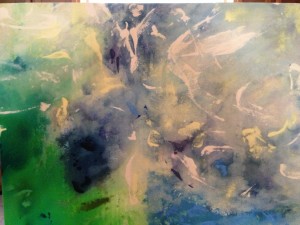I got a commission from a my friend Will’s parents for a piece for their new house. They gave me a giant blank wall and said I could do whatever I wanted. That’s always fun. This was by far the largest continuous piece I had done.
 Wishing Arch, 2013, two 48 x 62 inches, acrylic, fluid medium, and water on canvas
Wishing Arch, 2013, two 48 x 62 inches, acrylic, fluid medium, and water on canvas
I decided to use the technique I had previously developed that I guess I call “haloing”. I used this method for The Dirigible. The basic steps are,
(i) Using several layers of very diluted paint and unprimed canvas damp with water, create a few layers of stain, letting the paint soak into and spread around the canvas. There’s also a considerable amount of spraying with a spray bottle filled with water. The use of water allows the paint to spread and mix, preventing harsh lines between different colors. The paint is typically poured or dripped onto the canvas – lately, I’ve avoided using a brush for any purpose except applying water. So, this allows one to create broad, general ideas of color blocking. I used 2 or 3 layers of staining like this to build up color. The painting looks almost the same as the finished product, however, finishing here would create something incredibly boring, in my opinion. There’s no flair or intrigue at this point. There’s no expression. You can’t see the artist here, only the colors. That’s important.
(ii) After the staining is finished, it’s time for the the fun and artistic part, adding the thick paint. You have to be very careful during this step; it’s less forgiving than the staining. Too much will destroy the intrigue of the piece by creating something that looks overworked. Less is typically more, but too little, and you are left with something not much different that the staining layer. I try to avoid using a paint brush whenever possible, so the thick paint goes on here with a palette knife (actually, I just used a cheap plastic picnic knife). By using different edges of the knife, you can get broad thick strokes or use the other side and see the teeth marks (which I quite enjoy). Also, by pressing and smearing with the broad part of the knife, you can create very thin layers, so there’s a lot of variation you can employ. For the application of the thick paint, I first make sure the canvas is dripping wet. This is needed to cause the edges of the paint to smear and bleed around it (the “halo”). Also, I diluted the paint with a thin, transparent medium in order to water it down a little bit and help it spread. After applying the paint and surveying how everything looks, different areas are sprayed with different amounts of water, in order to help the haloing, depending on how much spreading I want where. Many different colors of the thick paint are used; your brain tends to automatically make a game out of finding and identifying the different colors and shades in each area. I also really like the 3D effect this step has.
I find it beneficial to model an abstract work on a picture or real life setting that I find interesting. I had been wanting to paint that cliff/water/sky landscape for a while, and so I chose it for that space. I thought that the colors would work well with their pool and plants around the house which are visible from the front room. I also thought that the color blocking would look interesting on a large scale. Of course, it’s an expressionist work, so I took a some liberties with it.
Painting on the floor of my apartment (thank you for putting up with me, Travis!):
Details:





